World Series Baseball 2K2 Preview
We visited Visual Concepts, and came back with the skinny on the upcoming baseball game.
While Visual Concepts was gladly redefining the sports simulation genre and entrenching itself among the top-tier of North American developers with its NBA and NFL 2K series, Sega's World Series Baseball 2K1, developed in Japan by Wow Entertainment, arrived to virtually universal disappointment. Wisely, for the second installment in the series, Sega placed the game's production in the capable hands of Visual Concepts, which proceeded to create an entirely new game in a little over a year. We recently visited the developer to get a glimpse of a near-complete build of the game and discuss the many tangible changes and improvements that are being made to the series. Aside from its title, World Series Baseball 2K2 shares very little with its much-maligned predecessor. The game is running on an entirely new engine, and new visuals, modes of play, and gameplay options allow it to more faithfully re-create America's favorite pastime. "Moving forward from 2K1, it was really important for us to have a great, really fun game and a deeper features set," explained David Perkinson, project manager at Visual Concepts. "We've also got this up and running, from the ground up, in such a short time--in pretty much a year, perhaps 15 months, of development time. This game is built entirely from the ground up; not one line of code is from last year's game."
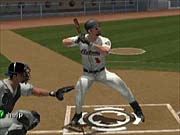
The key concept in the development of World Series Baseball 2K2 is one of realism, as the development team set out to create a realistic baseball simulation in all aspects, including graphics, features, options, and gameplay--a game that the avid baseball fan could enjoy. In the gameplay department in particular, three key areas have been addressed. They are the pitcher interface, the batter interface, and fielding. As mentioned in previous discussions of the game, the fielding system has been completely overhauled. Gone is the unwelcome auto-fielding feature, and in its place are full player controls. Like many other baseball simulations, once the ball is put into play, you can assume control of the player closest to the ball, retrieve it, and chuck it to one of the bases, which are mapped to the four face buttons on the Dreamcast controller. Actual player ratings will come into play on the field, as defensive categories such as range, throwing strength, and throwing accuracy are all rated for each individual player.
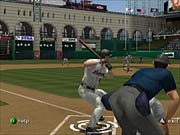
Equally extensive tweaks have been made to the batting interface, as the A button is now used to hit. In the first game, the analog stick was used for hitting, making it virtually impossible to check your swing. Those problems are a thing of the past, as you now have a lot more control over the entire swing and the interface feels much more intuitive in general. Further swing control is conveyed through the ability to either pull the ball or go to the opposite field. Although, it must be noted that, very much like in the first game, it's impossible to move the batter while he's in the box. While the batter remains in his fixed position, you must position a batting cursor--which is controllable even after the pitch is thrown--inside the strike zone and swing accordingly.
Complementing the general batting interface is the return of hot zones. Each of the batters in the game has his own unique hot zone--the area in the strike zone where his hitting is most effective. Additionally, each of the batters is rated against both left- and right-handed pitching in several key categories, including batting average, power, and clutch, among others. Some guys are more effective against righties and prefer to hit low and outside pitches, while others hit better against lefties and like the ball in and tight, and all this is reflected faithfully in the game. In similar fashion, the batting stances for many of the superstar players are totally unique--for example, Gary Sheffield has his signature stance with the bat cocked over his head, while Mark McGwire swings the bat by his knees until he's ready to hit. "Actually, we have 101 unique batting stances and nine standard stances for the rest of the players," Perkinson said. "So, we have 110 batting stances we can choose from." To add further realism, hand animations are implemented. So, when the player steps up to the plate, he'll actually grip the bat, moving each individual finger.
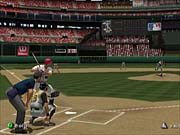
The pitching interface retains some of the elements from the original game, but there are also some new elements. Near the top of the list is a broader selection of pitches. Each of the pitchers is completely unique, as Visual Concepts has applied a large database of information to rate each pitcher in four different categories. Every pitcher in the game has nine pitches, and those nine pitches are in turn rated in categories such as movement, accuracy, and speed. This allows for a large number of permutations, as far as each of the pitcher's strengths and weaknesses are concerned. Visual Concept has also created more than 100 different wind-up animations, and they are individually broken down under three major categories: overhand, sidearm, and underhand. The pitching rotations are standard, with team rosters holding a five-man rotation, at least one long man, two setup guys, and a closer. According to Visual Concepts, the AI is generally intuitive in the way it makes relief substitutions. "The game is smart," Perkinson explained. "So, it won't bring in a long man in a situation where you're late in the game and pitching to a right-hander. It will instead bring in a lefty setup guy. It uses pitchers pretty intelligently, as the situation dictates." Changes are also evident on the bases, as the base-running tendencies of individual players are being worked into the game's AI. Smart base runners will recognize in-game situations and take an extra base if it's there, while more aggressive players will take off early in the count. It's now relatively simple to lead off the base, and the entire base-running system will come into play much more frequently in World Series Baseball 2K2 than in the previous game.
The extensive gameplay tweaks are matched by sweeping changes in the game's features and options. World Series Baseball 2K2 will come packed with six modes of play: exhibition, playoffs, season, franchise, home run derby, and online. The exhibition and playoff modes are pretty much self-explanatory. In the exhibition mode, you select any two teams, including last year's NL and AL all-star teams, to play a single game. The playoff mode lets you play a standard playoff schedule with last year's teams or use any of the 30 available teams to customize your own playoff season. Simple enough. It is the other gameplay modes--season, franchise, home run derby, and online--that warrant further explanation.
In the season mode, you can choose to control multiple teams, guide only your favorite team, or control all 30 Major League squads in one season. Naturally, the season length is adjustable. If so inclined, you can simulate the long and grueling Major League schedule by playing all 162 regular season games in order, or you can choose to play an abbreviated season of 20, 40, 81, or 120 games. Additionally, there are two different types of schedules: rigid and flexible. Playing in the rigid schedule, you must play every game in chronological order. Using the flexible schedule, you can play the games you want and simulate the others. You can also go ahead in time and play in the playoffs and World Series in October, and if you want, you can go back and play regular season games that you may have missed. The manner in which you tackle the season is left entirely up to you.
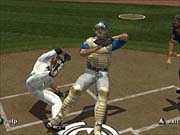
Complementing the single season is the franchise mode, which is new to this year's game. The franchise mode generally works similarly to other its counterparts in other Sega Sports games, such as the NBA and NFL 2K series. You can create, draft, trade, sign, and release players. You can also be involved in all aspects of baseball-specific roster management, such as editing the pitching staff, juggling starting rotations and the bullpen, and creating different batting orders. New to the franchise mode in World Series Baseball 2K2, and the Sega Sports lineup in general, is the inclusion of no-release and no-trade clauses in players' contracts. For example, when signing a player who demands a no-trade clause, you're generally stuck with that player until his contract runs out. This should add further team-management strategy to the game. Throughout the multiple seasons in franchise mode, players mature, reach their primes, and retire, and they're replaced by rookies, who all have their own unique scouting reports. These scouting reports will change as the players' careers evolve and as they acquire new skills and hone existing ones. As with the other Sega Sports games, rookie names are randomly generated by combining the first and last names of existing Major League players. In both the franchise and season modes, teams will carry a 25-man active roster and a 10-man minor league roster. The minor league rosters will include at least five pitchers (three starters and two relievers, or vice versa), several position players (with a good mix of infielders and outfielders), and at least one catcher. A roster of free agents is also available. In fact, there will be more than 1,300 individual players in the game, and this is before new fictional players are introduced through drafts in the franchise mode and created using the game's player creator.
Stat tracking is generally quite comprehensive. Team standings will be shown by division and by league. For the everyday players, the game will keep track of such stats as batting average, home runs, doubles, triples, RBIs, slugging percentage, stolen bases, and caught stealing, among others. For pitchers, it will track wins and losses, winning percentages, walks, ERAs, saves, strikeouts, hit batters, innings pitched, and more. This year's game won't go much deeper, as such information as statistics for day vs. night games and hitting stats for lefty vs. righty pitching won't be recorded. However, the fact that Sega will release the game mid-season has allowed the game's developer to take this season's performances into consideration when rating players and teams. "We've used last year's stats, but we've been changing the ratings almost every day," Perkinson said. "That's the advantage we have in shipping in the middle of the season. Like for example, who would have thought that the Minnesota Twins would be playing so well, and of course Barry Bonds going for the home run record is taken into consideration. We also have Ichiro and nobody else has him."
The home run derby is another new gameplay mode in World Series Baseball 2K2. In this mode, up to eight players can compete at once, with the top-tier guys advancing in each round. The game's three general skill levels will also apply to the home run derby, as you can choose to play on the rookie, veteran, or all-star skill level. The rookie level is straightforward and perhaps a little too simplistic. Here, you only have to press the button and swing, and chances are that the ball will go out of the park. In our first go-around with the home run derby, in rookie mode, we were cranking out homers of 500 feet or more with no effort. Thankfully, the veteran mode will add substantial difficultly, and actual player ratings will come into play. Here you will also be able to control the batting cursor, which isn't available in the rookie level. Finally, in the most difficult level--the all-star mode--the pitcher will throw a variety of pitches, making it even more difficult to crank one out of the park. Still, the home run derby is designed to showcase the long ball, and even the most inept batters can have their fleeting moments of glory in this gameplay mode. "Pretty much everyone in the home run derby gets a little bit of a bump," Perkinson explained. "So, even if you took a random relief pitcher in the home run derby, you might be able to hit one or two out. But obviously, you wouldn't have the same success as a power guy, like Bonds or McGwire."
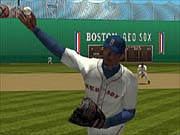
Rounding out the available modes of play is the game's new network mode. At this time, the network mode is receiving the brunt of the development team's attention as they iron out the final bugs. "The network is up and running, but there are still some bugs that need to be fixed," Perkinson said. "Once we get into a network game, it sometimes has the tendency to drop out after a couple of innings. Of the challenges right now, I'd say that the network is our top priority. But, it's coming along quite well and will be ready for the game's launch." As with its kin among the Sega Sports lineup, World Series Baseball 2K2 will let players compete head-to-head online over the SegaNet servers. The chat interface will be similar to that of the other Sega Sports games, and the SegaNet servers will keep track of player's win-loss record in online games.
One area where World Series Baseball 2K1 did succeed was in its visuals, but even there the sequel seems to boast some appreciable improvements. The player models, particularly for the superstar players, are incredibly lifelike, as accessories such as high socks, sunglasses, and glove color for each individual player are matched to their real-life counterparts. Batters standing in the box cast real-time shadows on themselves as stadium lighting illuminates the ballpark during night games. The flags in the ballpark, which are placed in their actual locations, blow to show the wind direction. The scoreboards are able to generate game information, such as pitch counts, live during the course of the game. Still, all this detail doesn't come without sacrifice, as Perkinson explained. "We're close to pushing the maximum performance on the Dreamcast," he said. "We have a host of players on the field and our batters are really high-poly models, so that takes up a lot of memory. Then, if we put elements such as the dugout that push us over the top, we have to steal stuff from somewhere else to make it happen. We wanted to include such things as the dugout, but in order for us to have the main players in the game look great and have it run 60 frames per second, we had to compromise. Of course, our goal is to go a little farther graphically next year, with all real-time lighting and self-shadowing through the entire ballpark."
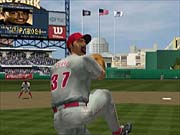
As with its other sports products, Visual Concepts seems to have paid a lot of attention to detail during the development of World Series Baseball 2K2. Outside of the changes already discussed, the developer has implemented full injuries, ranging from torn hamstrings to full-blown Tommy Johns surgery; added commentary by San Francisco Giants broadcaster Ted Robinson; designed a sleek new interface; and created a variety of player and team customization options. Visual Concept hopes that by trying to create a more realistic baseball simulation, it will be able to exorcise some of the gameplay deficiencies that plagued the Dreamcast's first baseball game and help cleanse the resulting disappointment. Since E3, the developer has added all the stadiums and rumble pack support, refined the gameplay system further, included the franchise mode and home run derby, and implemented the pitcher and batter intro cutscenes. Now, it has turned its attention to the network mode and some final bug testing as it prepares for the game's July release.
Got a news tip or want to contact us directly? Email news@gamespot.com
Join the conversation